- Member DIN
- S770
So finally the time has come where I show my process of making my Reach undersuit!!
First and foremost, I want to give initial credit to WandererTJ , Because He is the one who made the pepakura model of the undersuit that I used to make my patterns, and KitKatGoose , Who I originally got the idea from! Thank you both for all the help!! Here are some completed pictures of the undersuit so you can see what I'll be showing you how to make!



First and foremost, I want to give initial credit to WandererTJ , Because He is the one who made the pepakura model of the undersuit that I used to make my patterns, and KitKatGoose , Who I originally got the idea from! Thank you both for all the help!! Here are some completed pictures of the undersuit so you can see what I'll be showing you how to make!
Last edited:

